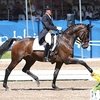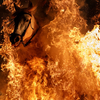
Endurance Rules 2020: TO BE OR NOT TO BE
Автор: Jelena Sbitneva
One of the important issues at the General Assembly in Moscow is the approval of new Endurance rules, which will be effective 2020. Jelena Sbitneva, owner of Padise Equestrian Centre, a professional international endurance base, located near Tallinn (Estonia), shared her opinion on this subject.
Have you seen the draft new rules?
Yes, I have. They are completely rewritten from scratch. They have a lot of fundamental changes that have already received negative reviews from the endurance community.
What is wrong with them?
The main problem of the proposed rules, in my opinion, is that they do not take into account all aspects of our discipline, which is developing dynamically due to the new generation of young riders. Therefore, I, with all frankness, can name many paragraphs of the rules that are detached from reality. And this is not only my personal opinion - many endurance riders express their fear that, if new rules are approved, endurance riding may lose the current dynamics in its development.
Can you give any examples?
Sure! The most controversial part of the proposed rules is a new and very complicated qualification procedure for international competitions, especially for participation in championships. Now the qualification process for the rider and for the horse may take several years, especially in small countries where a small number of international competitions are held. This can lead to a significant increase in costs, both for athletes and for the organizers, and as a result, to make sports more expensive in general.
Another innovation is that the minimum weight requirement for young riders and juniors has been added: there was no such thing before, but now the required minimum is 60 kg including all riding equipment except for the bridle. In most cases, juniors are young girls with an average weight of about 50 kg. So, now they will have to add special weight of 10 kg to the horse’s back, which will not benefit the horses and may even cause lameness.
Will there be any changes in the veterinary control procedure at competitions?
There will be. It is proposed to reduce the recovery time for the horse before passing the veterinary check. According to the current rules, the horse has 20 minutes in the intermediate phases and 30 minutes after the finish to restore its pulse to 64 beats per minute. The new rules suggest that the recovery time will be reduced to 15 and 20 minutes, respectively. Such a severe restriction will have a negative effect on young and inexperienced horses that may be nervous and need more time to recover. Reducing the recovery time will increase the number of disqualifications of participants, and make it harder for them to gain the necessary experience for becoming successful at completions. Moreover, such a measure was already proposed last year, and was rejected.
Will the new rules directly affect the organization of events?
Yes, they will and very significantly. Now restrictions are introduced on the work of officials at a particular venue. Let me explain: in small countries, the same officials work many times at the same venues (judges, stewards, technical delegates and accredited veterinarians) - this is common due to the fact that it’s expensive for the organizers to invite officials from other countries. The new rules propose setting a limit on the number of competitions in which an official may serve: for the events held at the same venue, an official can work no more than three times a year, and no more than 9 times in a five-year period. This is impetuous!
In addition, now the organizers themselves choose officials for their competitions. In order to save the money, they often invite the officials either from their own country or from neighboring countries to reduce the cost of organizing the event. But, according to the new proposed rules, most officials for 3* events will be appointed by FEI. And if, for example, the official from America or Australia is appointed as President of Ground Jury to the competition in Russia then in this case, not every organizer will be able to increase the budget to cover travel expenses of such appointed official.
If the organizers have to increase costs, it is obvious that they will be forced to charge them from the participants of the competition, increasing the amount of the entry fees.
This rule will also worsen the situation for the officials themselves, because, for example, for veterinarians, the work in competitions is not a hobby, but part of the profession to make a living.
Another very important issue arose suddenly. The new rules suggest that every international competition from 1 * to 3 * requires a chief steward of the highest 3* level. The fact is that there are not a lot of people of such qualification - only 63 all over the world, while more than 300 FEI Endurance events are held annually. It turns out that chief stewards of 3* level will be in great demand, everyone will have to attend 5 competitions. And since in real life not all officials have free time to attend the events, in fact, the number of competitions for each chief steward may increase. And if competitions are held several times in one location, then a conflict may arise: the above-mentioned limit for officials to work no more than 3 times at a particular venue might not allow these 63 chief stewards to serve at all 300 events.
In general, as I said, the impression is that the new rules are drawn up without taking into account the events on the ground, and are based solely on theory and statistics, which have no correlation with real sports. For example, a year ago there was a proposal to introduce into the rules a clause on an additional period of mandatory rest between competitions for horses if they finished the competition at an average speed above 20 km/h. Last year, this proposal was rejected by delegates of the General Assembly. This proposal has now been reintroduced into the draft new rules. Moreover, in the first draft there was a figure of 22 km/h, and in the final one they again set it to 20 km / h. Such a scatter in numbers shows that the authors of the rules themselves cannot decide what speed should be considered dangerous in terms of horse welfare.
Moreover, strict penalties have now been introduced if the rider is eliminated from the competition and at the same time his speed is over 20 km/h. Thus, for two consecutive eliminations or for three eliminations in a one-year rolling period (if in each case the average speed was over 20 km/h), a speed limit of 18 km/h is applied to this rider or horse in future competitions. It is necessary to successfully complete one or two competitions with such a limit in order to obtain the right to compete again at free speed.
Moreover, the speed limit itself contradicts the common sense of the endurance sporting event, in which the winner is determined by the shortest time (against the clock), and the reasons for elimination can be anything besides high speed.
And if a speed limit is applied in the competition, then a situation may arise when several riders will make the dead heat finish at the same speed exactly 18 km/h at the same time, and it will not be clear how to determine the winner in this case.
Indeed, it looks a bit strange ...
It’s not the entire story. Here is another example. If a horse has changed the trainer, it will not be able to compete for 30 days. This is certainly a strange and incomprehensible restriction that deprives horses of a chance to compete, especially since the endurance season in many countries is very short due to the climate. And how this 30-day ban will help ensure welfare of horses is also unclear.
Under the new proposed rules, the Novice Qualification procedure also changes. Now, one has to complete two national qualifying competitions of 80 km each within two years to be eligible to participate in international competitions. There is an exception for the horses of 8 years and older – they have to cover a minimum of 480 km in a three-year period. But this does not make any practical sense. Why should one cover 480 km for Novice Qualification if one can get it according to the new standard procedure, completing twice an 80 km distance - a total of 160 km in two years.
From the discipline that was initially available to everyone without limitation in the quality and price of horses with minimal financial costs, endurance riding bears the risk of becoming a sport “for the rich” and only with elite horses, thereby significantly reducing the number of athletes and horses around the world. Ultimately, this will lead to stagnation of our discipline.
How important is financing of equestrian sports in general and endurance in particular?
Let's be honest - nowadays, no promotion and existence of sports in general is possible without money. Endurance is a non-Olympic discipline that requires a lot of investment to organize competitions, and it’s extremely difficult to find sponsors for this discipline.
There are very few sponsors who invest huge amounts every year in organizing endurance competitions in many countries of Europe and the world. Literally, the occasions are specific - example, the Meydan Group from the UAE, which finances the majority of endurance championships.
We must appreciate and respect such sponsors because without them there would be no rapid development of endurance at such a high level.
What are your short-term plans for equestrian sports?
Every year I strive to hold as many competitions as possible, while trying to improve the quality of the organization each time. Padise Equestrian Centre is planning to hold 6 international events - parts of the Padise Endurance Festival in 2020, which will take place on May 20-23, June 3-6, June 17-20, June 29-July 2, July 15-18, and 19- August 23.
We also applied to host the World Endurance Championship at Padise in 2022. In addition to Estonia, applications for 2022 were filed by organizers from Italy, Saudi Arabia and the United Arab Emirates. We are looking forward to the decision on the venue, which will be taken at the FEI General Assembly in Moscow.

GM note: Jelena Sbitneva
Member of the endurance committee of the Estonian Equestrian Federation, professional endurance rider, trainer, organizer of the Padise Endurance Festival, horse owner and horse breeder, chef of the international endurance equestrian team, owner of the Padise Equestrian Centre (Europe’s first professional endurance riding equestrian center with permanent vet gate).
She has a bachelor's degree in international relations and a master's degree in international law, graduated from an art school. In her free time she works on her future clothing collection, which is related to horses and equestrian theme.
Motto: "Do only the best, or do nothing."
Read more about Padise Equestrian Center - www.pec.ee
















